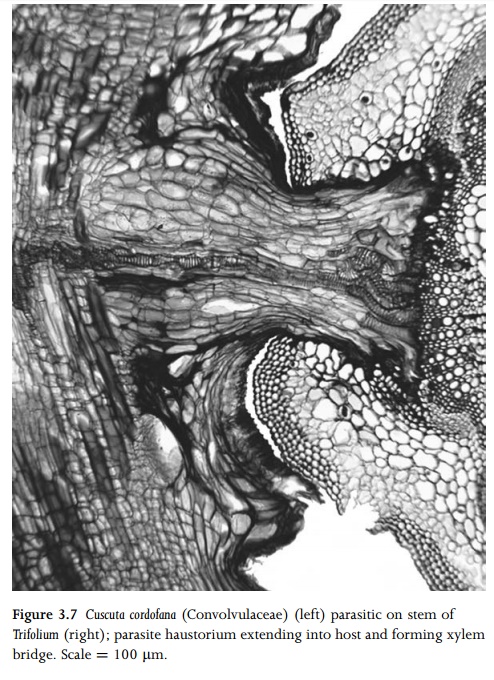Chapter: Anatomy of Flowering Plants: An Introduction to Structure and Development : Root
Haustoria of Parasitic Angiosperms
Haustoria of Parasitic
Angiosperms
Some
angiosperms are parasitic on the roots, stems and leaves of other angiosperms.
These include mistletoe (Viscum album), dodder (Cuscuta spp.), sandalwood
(species of Santalaceae), broomrape and figwort (species of Orobanchaceae).
Parasitic plants produce highly modified structures, termed haustoria, that penetrate
the host tissue to transfer nutrients from the host to the parasite66.
A primary haustorium is a direct outgrowth of the apex of the radicle of the
parasite. A secondary haustorium is a lateral organ that develops from a
modified adventitious root or from out-growths of roots or stems.

In some parasitic species the haustorium penetrates the host tissue to the xylem and forms a continuous xylem bridge
(Fig. 3.7). The epidermal cells in contact with the host become elongated and
secretory, and the centre of the haustorium develops an intrusive process that
grows into the host by enzymatic and mechanical action. In many parasites (e.g.
sandal-woods), the developing haustorium forms a mantle of parench-ymatous tissue
around the host organ. In some Loranthaceae the haustorium does not invade the
host tissues after forming a mantle, but instead induces the host tissue to
form a placenta-like outgrowth of vascular tissue to supply nutrients to the
parasite. When the parasite dies, a woody outgrowth of convoluted host tissue
remains as a vestige known as a ‘‘woodrose’’.
Related Topics